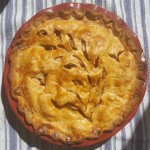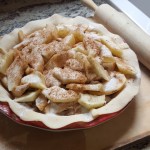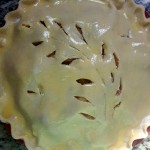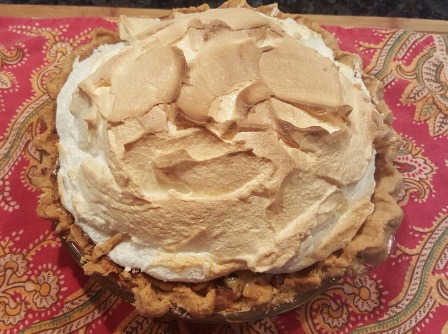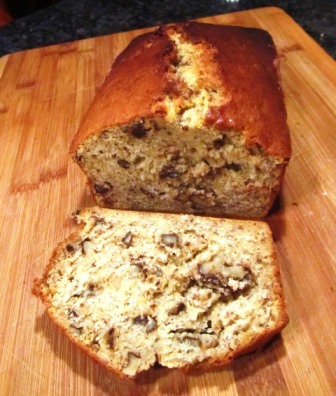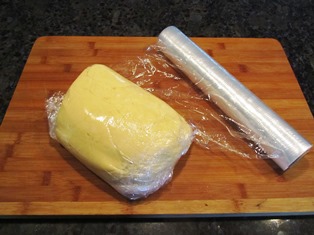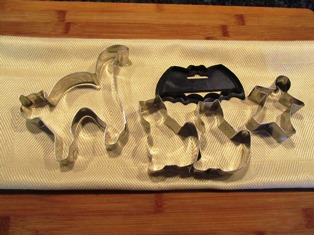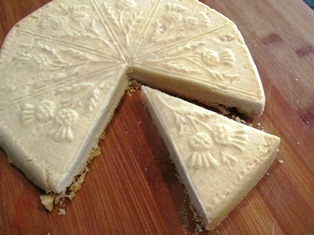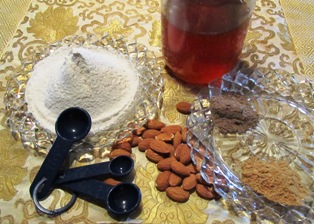Pie to Welcome Autumn, Plus a Few Apple Facts
Autumn officially arrives next Friday, September 22, 2017. That means peak apple season has begun and nothing says “fall” like an early-autumn apple pie.
Here’s my easiest apple pie recipe.
COUNTRY APPLE PIE
Ingredients:
6 cups apples, peeled, cored, and thinly sliced
3/4 cup granulated sugar
2 tablespoons butter
1/8 teaspoon salt
1 teaspoon cinnamon
1/2 teaspoon ground nutmeg
2 tablespoons flour
2 unbaked pie crusts (homemade or store-bought)
1 egg, beaten with 2 tablespoons water (to make an egg wash)
Directions:
Preheat oven to 450 degrees Fahrenheit
Combine sugar, flour, salt, cinnamon, and nutmegr in a large bowl and mix well. Stir in the apples. Spoon the apples into a pastry-lined baking dish or pan. Cut the butter into small pieces and distribute over the apples. Place the second rolled-out crust over the pie. Snip off the excess crust and cut a design into the top crust to create a steam vent. Flute crust edges. Use a pastry brush to apply the egg wash over the top crust.
Bake for 10 minutes. Cover crust edges with aluminum foil to keep them from burning. Reduce heat to 350 degrees and bake for 30 to 35 minutes. Crust will be golden brown and juices will be bubbling.
FACTS ABOUT APPLES
1. Apples were known in the ancient world; they’ve been around for 3,000 years.
2. Apples thrive in a temperate climate and are grown worldwide.
3. There are roughly 7,000 varieties of apples worldwide, all members of the rosaceae family.
4. Washington state produces half of all U.S. apples.
5. Science shows that apples are rich in antioxidants and vitamins A and C, are high in fiber, and and aid in lowering cholesterol and high blood pressure. They can help stabilize blood sugar levels.
6. Some of the best-loved apple varieties include: Braeburn, Red Delicious, Granny Smith, Gala, Fuji, Golden Delicious, Honeycrisp, and Rome.
If you want to know which apples are best for baking, eating fresh, making into sauces, or freezing, see, http://bestapples.com/varieties-information/varieties/
_____________________________________________________________
If you enjoy reading about delicious farm recipes, growing heirloom plants, or keeping bees and chickens and you like a mysteries, check out my Henny Penny Farmette series of cozy mysteries from Kensington Publishing in NY. They’re available online and in traditional bookstores everywhere.

Murders at a N. California winery are the catalyst for ex-cop turned farmette owner Abigail Mackenzie to search for a killer
Currently, A HIVE OF HOMICIDES is a featured title in Barnes & Noble’s September promotional BUY 3, GET 1 FREE sale.
WHAT IS THE BUY 3, GET 1 FREE OFFER?
Everyone who buys a Kensington cozy mystery from the B&N in-store display or any Kensington cozy mystery from BarnesandNoble.com between 9/5/17 – 10/5/17 and registers their purchase at http://sites.kensingtonbooks.com/kensingtoncozies/BN/ will:
— Automatically be entered into Kensington’s “Cozy Mystery Bonanza” sweepstakes for a chance to win a $300 value gift basket. One grand prize winner will be selected after the sale has concluded.
— Automatically receive a free Kensington Cozies recipe booklet plus a download code for the novel A STORY TO KILL by Lynn Cahoon after the sale has concluded.
* * *
DON’T FORGET TO ENTER THE FREE DRAWING AT GOODREADS.COM.
Win a signed copy of A Hive of Homicides along with a gorgeous reversible apron and a set of 2 chicken napkin rings. Enter before September 26 for a chance to win.
See, https://www.goodreads.com/book/show/33911114-a-hive-of-homicides?from_search=true
Great Pie Begins with a Buttery, Flaky Crust
My stalwart Scots-Irish grandmother was thrifty and talented when it came to food preparation. She made delicious pies from cherry, rhubarb, peaches, apples, pears, and sweet berries of every kind, including gooseberries. Her pies were my childhood delight when I lived with her and my grandfather on their Boone County, Missouri farm.
She made delicious meat pies from meats she’d preserved by canning. Missouri winters could be harsh. Those meat pies nourished me when the snow piled up outside the windows, and it was too cold to make a trek to the smoke house where her prized Boone County hams hung from hooks.
Sometimes, my grandmother combined fruits or berries in a rustic pie (today, we call it a galette) and on other occasions, she made a raisin, pecan, pumpkin, coconut, or a custard pie. And meringue, if used, was high and sweet and just the right shade of golden brown. But it was the pie crust that I loved.
For the top of a peach pie, she’d cut in a large curve shaped like a branch. Then two or three other lines would curve from it. Lastly, she cut teardrop shapes along the arch lines so the top crust art would suggest a peach tree branch. When she worked crisscross strips atop a cherry pie, it was both beautiful and delicious.

Storing or rolling the crust between sheets of plastic wraps is a good way to avoid handling the crust with your hands.
The secret to her buttery, flaky crust was not to handle it too much. Today, I make the same recipe but in my food processor. Like her, I use chilled or ice water, adding only drops at at time as the food processor is pulsing the dough–only enough to get the dough clinging together. The point is to move the dough from dry and crumbly to clumping into a ball.
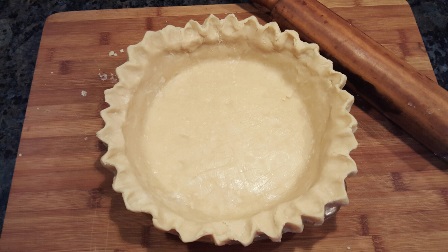
This fluted crust is ready for almost any kind of filling. I will prick the bottom and sides with a fork before filling and baking.
After the dough is made, I dump it from the food processor bowl onto aluminum foil or plastic wrap and work it into a ball (without touching it). The dough goes into the fridge for a chill over an hour and up to 24 hours. The recipe makes enough for a pie top and bottom or a couple of pies requiring only the bottom crust.
Ingredients:
2 1/2 cups flour
1/2 teaspoon salt
1 teaspoon granulated sugar
1 cup chilled unsalted butter, cut into pieces
1/4 (plus a few tablespoons more if necessary) cold or ice water
Directions:
Add the dry ingredients (flour, salt, and sugar) in the food processor bowl.
Cut the butter into small chunks and drop the pieces in. Pulse into a crumbly, dry meal.
Add ice water to the mixture in the bowl by dropping spoonfuls through the feeding tube and pulsing after each addition.
Remove the dough when it clings together–neither too wet nor too dry–by dumping it out on a large sheet of aluminum foil or plastic wrap.
Mold the dough into a ball and flatten into a thick disk to make it easier to roll out.
Chill for an hour or up to 24 hours.
Makes two buttery, flaky crusts.
* * *
If you enjoy reading about farmette topics (including gardening, beekeeping, and delicious recipes), check out my cozy mysteries A BEELINE TO MURDER and also THE MURDER OF A QUEEN BEE in the Henny Penny Farmette series (from Kensington Publishing).
These novels are available through online retailers such as Amazon, Barnes & Noble, Kobo Books, and Walmart as well as from traditional bookstores everywhere.
See, http://tinyurl.com/hxy3s8q
Now available in mass market paperback, this debut novel launched the Henny Penny Farmette series of mysteries and sold out its first press run.
See, http://tinyurl.com/h4kou4g
The second cozy mystery in the Henny Penny Farmette series, available Sept. 27, 2016, is now available on Net Galley (netgalley.com) for professionals and readers who write reviews.
Traditional Banana-Walnut Bread
When the bananas on the kitchen counter become soft and the peels develop brown freckles, don’t toss them. Make a loaf of banana-walnut bread. This bread makes a lovely complement to a cup of steaming, fragrant Earl Grey tea.
The ingredient list for this bread is simple and the directions are easy. To start, you’ll need a 9 by 5-inch loaf pan, greased and floured; and, you’ll need to affix the paddle to your mixer. Set the oven to 350 degrees Fahrenheit. The recipe yields one loaf.
RECIPE: TRADITIONAL BANANA-WALNUT BREAD
Ingredients:
6 Tablespoons of softened, unsalted butter
1 cup sugar
1 1/2 cup mashed ripe bananas
3 large organic eggs
1/2 cup buttermilk (or 2 Tablespoons buttermilk powder dissolved in 1/2 cup warm water)
2 cups all-purpose flour
1 teaspoon baking powder
1 teaspoon baking soda
1 teaspoon ground nutmeg
1/2 teaspoon salt
1 cup walnuts, coarsely chopped
Directions:
Mix together in a large bowl the following–flour, baking powder, baking soda, nutmeg, salt, and chopped nuts. Set aside.
In the mixer bowl, cream the butter and sugar.
Add the bananas.
Add one egg at a time.
Add the buttermilk.
Pour the flour into the banana mixture and mix a little at time until the ingredients are all combined.
Fill the floured and greased loaf pan with batter until the pan is roughly 2/3 full.
Bake for approximately 55 minutes or until a toothpick inserted into the batter comes out clean.
*Tip: ripe bananas can be peeled and stored in a zip-lock freezer bag and frozen.
Not-So Spooky Halloween Cookies the Kids Will Love

Let the kids decorate these not-so scaredy cats, using colors they like. Add orange or black sprinkles to finish.
When you let the young ones in your family choose the cookie cutter shapes and icing colors, you’ll get plenty of helping hands making cookies for Halloween. I make these cookies a lot; they are perfect for any holiday and also for children’s tea parties. Just change the shape and bake and decorate.
After making the dough, wrap in plastic and refrigerate for at least an hour to make the dough a bit firmer for rolling out.
Half the fun is dumping onto the counter an assortment of cookie cutters and letting the kids choose their favorites. For Halloween, they might like ghosts, cats, bats, witches, and pumpkins. Help them roll out the cookies and place them on the cookie sheet for baking.
Sugar Cookie Recipe
Ingredients:
1.5 cups butter (softened if cold)
2 cups granulated sugar
4 large eggs
1 teaspoon vanilla
5 cups white all-purpose flour
2 teaspoons baking soda
1 teaspoon salt
Directions:
Cream butter and sugar together.
Slowly beat in eggs and vanilla.
Add flour, baking powder, and salt and mix together until thoroughly blended and dough can be shaped into a ball.
Cover with plastic wrap and chill in the refrigerator for at least one hour. You can also chill the dough overnight. If you don’t want to make the cookies all at once, then divide the dough into two balls to use when you want.
Preheat the oven to 400 degrees Fahrenheit.
Sprinkle flour onto a flat surface and roll out the dough to roughly 1/4 inch thickness.
Cut into shapes using your favorite cookie cutters. Arrange cookies on a baking sheet leaving 1 inch between cookies.
Bake 7 to 10 minutes.
Let cool before icing with your favorite sugar cookie icing.
A drop or two of food coloring can give you various colors of icing; , just be sure to put icing in separate bowls before adding the food coloring. Use a pastry bag with tips or even a toothpick to make designs on the iced cookie. Decorate with sprinkles.
Rustic Pluot or Plum Tart with Italian Crostata Crust
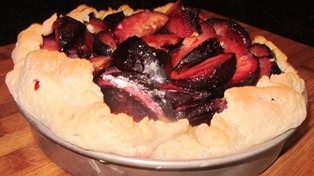
Pluots or plums are first drizzled in lemon juice and dusted with flour, then placed into the tart with bits of butter
The farmer’s market has the dark purple-black plums and pluots in abundance now, so I thought I’d buy a few and whip up a rustic summer tart, Italian style.
I like the rustic tarts with the Italian style crostata crust because they are easy to make and the tart tastes so buttery and flaky. This recipe uses butter and also cream cheese that gives the tart a special lightness. For the filling, I used pluots for this one, but you could also use ripe plums.
To make the dough, I find it easier to just put the ingredients into the food processor with a steel blade and pulse a few times, adding ice water as needed.
Ingredients:
8 ounces cream cheese
2 sticks butter (1 cup)
2 cups flour
½ teaspoon salt
1 teaspoon cold water
6-7 large sweet pluots or dark plums
Juice from ½ medium lemon
2 Tablespoons butter
2 Tablespoons flour
Directions:
Preheat oven to 375 degrees Fahrenheit.
In a food processor with blade, process cream cheese, butter, flour, salt, and water into a ball.
*Roll out on a lightly floured surface in a circle to about ¼ inch thickness and 2-4 inches larger than your tart pan.
Place dough in a tart pan and pre-bake 10 minutes.
Wash, cut, stone, and cut pluots/plums into quarters.
Combine with lemon juice.
Toss with flour. If plums are juicy, you’ll need a bit more flour to absorb all that juice.
Cut butter into pieces and scatter around the plums as you layer the slices in the pan on top of the crostata dough.
Fold extra dough loosely back over the plums; it should not reach the center because you want a rustic look to the baked tart.
Bake for 30-45 minutes until pluots/plums are soft and dough is golden brown.
Serve warm with a dollop of whipping cream or a good vanilla ice cream.
*Avoid over-handling the dough as it will become tough.
Melt-in-Your-Mouth Scottish Shortbread
Warm Scottish shortbread and tea are two of the simple pleasures of life.
Scottish shortbread, that buttery biscuitlike treat that Scottish cooks are famous for serving at teatime, doesn’t require a lot of ingredients; it’s basically flour, butter, and sugar. Of course, the dough can accommodate other additions, for example, bits of dried fruit, chocolate, caraway seeds, lemon zest, chopped dates, and nuts. I like it best plain.
I have many recipes for shortbread. Some are from magazines or books devoted to the subject of Irish or Scottish culinary traditions or foods of the British Isles, acquired during my travels to the lands of my ancestors, namely, Scotland, Wales, and Ireland.
With shortbread, more butter, less flour produces a richer biscuity cookie. It’s helpful to remember the basic 2-4-8 formula, that is: 2 ounces of sugar, 4 ounces of butter, 8 ounces of flour, plus a pinch of salt. Mix together, press into a mold, and bake 45-60 minutes in a 325-degree Fahrenheit oven until golden. Dust with sugar.
The following is my favorite recipe, slightly different. It is pictured above. Feel free to add to it your favorite ingredients.
Ingredients:
1/2 cup powdered sugar
1/3 cup rice flour
2 cups all-purpose flour
pinch of salt
pinch of baking powder
1 cup unsalted butter
Directions:
Preheat the oven to 350 degrees Fahrenheit
1. Put dry ingredients into a mixing bowl.
2. Add butter and cut in with a butter cutter or knives until it is thoroughly incorporated into the dough.
3. Knead the dough 2 minutes on a lightly floured surface.
4. Divide dough into two, roll into balls, and cover both in plastic wrap.
5. Chill for one hour.
6. Knead the dough balls back together to soften and then roll out to about 1/4 inch thickness.
7. Press into a shortbread mold or cut into shapes with a cookie cutter.
8. Bake for 15 to 20 minutes or until the dough is golden and cooked through, if using a mold. For cookies, bake on ungreased baking sheet.
9. Dust, if you like, with fine granulated sugar (also called castor sugar).
Old World Honey Cake
Honey cake has been called the world’s “oldest-known cake.” Versions of the cake date to biblical times, although food historians will tell you that it wasn’t really called cake back then. The English term “cake” dates to the thirteenth century and derives from the old Norse word, “kaka.”
Modern pastry chefs have the ancient Egyptians to thank for pioneering the culinary process of baking. The ancients’ version of honey cake was most likely an old-world type of flat bread drizzled or lashed with honey, the sweetener of choice during ancient times. In fact, bread and cake (even today) are not too different. Think of pumpkin bread or banana nut bread. A slice of either at breakfast is like having dessert in the morning.
The Romans added eggs and butter to get a lighter dough. Cooks began to add nuts and dried fruits such as dates, figs, and raisins to make their honey “cake” even more mouth-watering and special.
Although that round shape that we associate with cake today didn’t emerge until the seventeenth century, medieval bakers in Europe had for centuries continued to create new versions of the honey cake with spices such as ginger. In fact, the taste for ginger resulted in gingerbread. The addition of dried fruits, nuts, spices, and (later) rum and brandy yielded the cake we know today as fruitcake.
The following recipe is more of a medieval style honey cake, although during the medieval period cakes tended to be smaller than we think of them today.
Old World Honey Cake
Ingredients:
1 cup plus 1 tablespoon honey (preferrably dark)
1 teaspoon cinnamon
1/2 teaspoon ground nutmeg
1/2 teaspoon cardamom
2 teaspoon baking soda
1/2 cup softened unsalted butter
1 cup dark brown sugar
4 eggs (separate yolks from whites)
1/2 cup unflavored Greek yogurt
1/2 cup cottage cheese
1 tablespoon fresh orange zest
2 1/2 cups flour
1/2 teaspoon salt
1/2 cup raisins
10 dates, stoned and chopped
1 cup walnuts, finely chopped
Directions:
Preheat the ove to 300 degrees Fahrenheit. Grease a ten-inch tube pan.
Combine honey, cinnamon, nutmeg, and cardamom in a saucepan over medium high heat and bring to a boil, stirring often. Add baking soda, stir in, and remove from heat and let cool.
In a mixing bowl, cream butter with brown sugar. Beat in one egg yolk at a time. Add this to the honey/spice mixture.
In a bowl, mix yogurt, cottage cheese, and orange zest.
Sift half the flour and the salt into the honey/spice mixture (that now also contains the creamed butter, sugar, and eggs). Combine remaining flour with raisins, dates, and walnuts. Mix this into the bowl of batter.
Pour the batter into the greased tube pan and bake for 1 1/2 hours. Test for doneness by inserting a toothpick into the cake. The toothpick, when pulled out, should have no batter on it.
Cool the cake for 15 minutes before inverting. Brush with 1 Tablespoon of honey.
Optional: Sprinkle with slivered almonds. After the cake is completely cooled, store in an airtight container for 24 to 48 hours before serving.
Copyright Meera Lester 11-28-2012
 Facebook
Facebook Goodreads
Goodreads LinkedIn
LinkedIn Meera Lester
Meera Lester Twitter
Twitter






